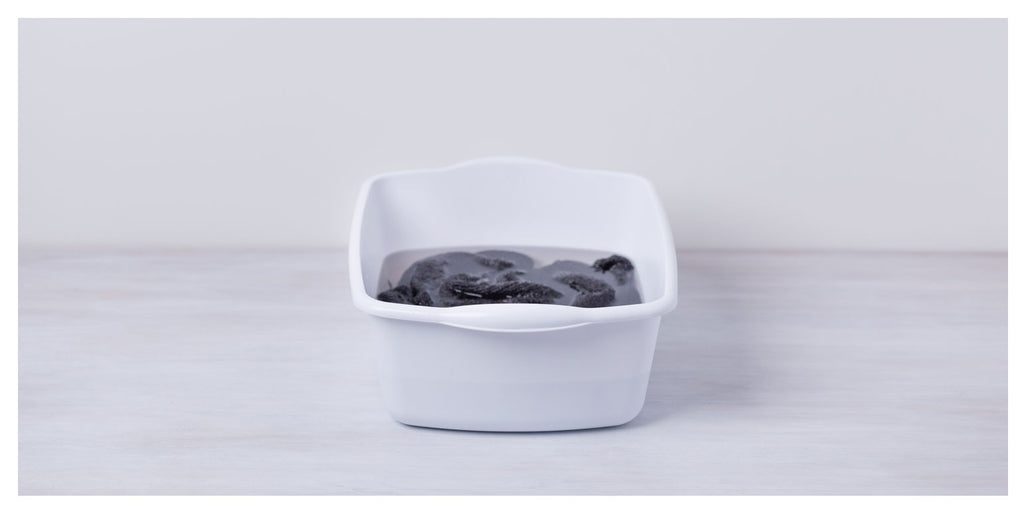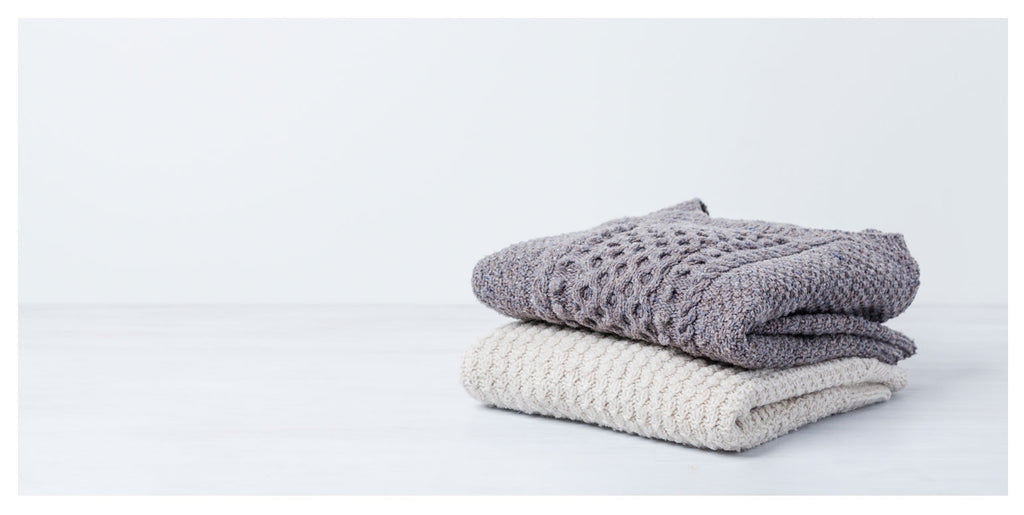One of the many reasons we love wool and wool garments is that they are resilient and have the potential for a long, hard-wearing, and useful life. Repaying this wonder fiber’s diligent services in kind through proper care and attention ensures that your wool garments and handknits will live even longer, and look as pristine as the new garments you knit or add to your wardrobe over the years. Thus, we’d like to share with you some of the best practices we’ve discovered for caring for your handknits — from freshening them up in between wears to spot-cleaning, de-pilling, steaming, washing, folding, and storing them away for the warmer months.
If you find this tutorial helpful, we’d love your support!
Shop our breed-specific American wool yarns & thoughtfully designed patterns.

Freshening Between Wears
Wool is known to have antibacterial and antimicrobial properties, and is also breathable, absorbing perspiration and moisture while keeping the skin dry. Thus, it is not necessary to wash your wool handknits after every wear! In fact, frequent washing can cause more damage and fading. We normally wash seasonally, for example, after the cooler months in preparation for storing handknits away for the summer.
To keep your woolies fresh in between wears and seasonal washing, simply let them air out, either by laying them flat on a chair overnight and/or giving them a gentle shake from time to time. If your knitwear picks up smells or odors throughout the day (e.g. from perfume or cooking), you can let it air-dry outside, away from direct sunlight. Try to rotate your knits throughout the week as well, rather than wear one piece day after day, however cozy that may sound! This allows each of your knits to have their own time to freshen up and breathe. The recommended rest time in between wears is 24 hours.
Spot-Cleaning
To keep your knits in even better shape between wearing and washing, take care to avoid food or liquid spills — and diligently watch where you place your sweatered elbows. Fortunately, wool is naturally soil-resistant; while it can absorb moisture, it also readily repels it. So, in the event of a spill, you’ll have time to quickly blot before a stain sets. Simply pat the area with a paper towel or cloth, letting the moisture wick off before dabbing the rest of the area. Try not to rub or agitate the fabric, so as not to felt or weaken it. For food spills, brush off the food particles as best as you can, and gently clean the area with a sponge and soapy water.
De-Pilling
Pills, or small balls of fluff, may develop on the surface of your wool garments over time — especially in areas that receive frequent day-to-day abrasion, such as the sides of a sweater that rub against your arms when you move. Pilling is primarily due to short staple lengths in the fiber working their way out of the twist in the yarn. To remove them, simply brush off gently with a sweater stone or a sweater brush.
Steaming
Steaming is also a great way to freshen up your wool handknits between seasonal washing. The warmth and moisture of the steam relaxes the fabric of your piece, flattening wrinkles and smoothing creases from folding. You can lay your garment flat in a steamy bathroom, invest in a small garment steamer for quick results, or use a steam iron. For the latter, lay your garment flat over an ironing board or another heat-resistant surface and hold the iron about an inch above it as you surge the steam (do not allow the iron to come in contact with the fabric). While the fabric is warm and damp, use your hands to smooth it out and reshape to your liking. Apply more steam as you see fit and then leave to air dry.
You can also place a damp pressing cloth over your knitted item and press your iron over it gently and briefly. Avoid ironing the fabric by dragging the soleplate over it. Simply press down with very light pressure and lift the iron off again. Repeat this lifting and pressing for any areas of the garment that need smoothing.
For steaming the crown of a hat, stuff the item with rolled up fabric, towels, or a pressing ham and apply steam to the outer fabric. To smooth out a fold crease on a sleeve or to round out the shoulders of a yoked sweater, roll up a towel like a makeshift seam roll, stuff under the fabric, then apply steam.

Washing
Unless your wool garments get particularly soiled during wear, you can generally wait until the warmer months (when they won’t get as much use) to wash them. Washing your woolies before you put them away for storage is immensely important, as this will ensure that no residual dirt, makeup, perfume, and/or skin oils damage the garment or attract natural fiber lovers like moths.
Hand washing is the best way to clean your wool garments as it is a much gentler process than washing with a machine. Contrary to what others may think, hand washing is actually quite simple and effortless! In the words of June Hemmons Hiatt, author of The Principles of Knitting, hand washing your knits “is somewhat like baking bread; you deal with it lovingly every now and then for just a few minutes, and then you ignore it for a while.”
First, fill a clean sink or basin with water. For water temperature and soaking time, follow the manufacturer’s recommendations for the yarn used. For knits in any Brooklyn Tweed yarn, use cold water and soak for 15 minutes. To soak, submerge the fabric, gently squeezing out any air bubbles so that the piece can remain under the water without being held there. Never place any wool item under running water as this motion may felt or full the wool. You can add a small amount of delicate dish soap, rinseless wool wash, or Tuft Woolens Wool Soap to the soaking water if you wish; if not rinseless, you will need to re-submerge the piece in clean water once or twice to remove the soap from your fabric.
Watch the video — How To Use Tuft Woolens Wool Soap
Remember one simple rule: don’t do anything to an animal fiber garment that you wouldn’t do to your own hair. No dry cleaning, no harsh detergents, no hot dryer — that’s how you end up with either a scratchy sweater or a really bad perm!
Once your garment has finished soaking, lift it out of the water, making sure to support its weight evenly so that the wet fabric doesn’t sag and stretch the garment — wool can absorb a lot of water and become quite heavy! Gently squeeze (never wring) to remove excess water. Then roll the garment in a towel “burrito-style” to squeeze out more moisture.
Finally, lay the damp garment flat to air-dry over a layer of fresh towels or on top of a blocking mat. After initial blocking, wool garments rarely need another stretching and pinning. However, if you are concerned that certain areas of your garment have changed in size during wear, you can certainly pin them back to your desired measurements while it’s still damp. If using towels, after a couple of hours, flip the garment over and lay a new towel underneath.

Folding & Storing
Once your wool garment is completely dry, you can fold it and store it away. Folding is key here — try to avoid putting larger garments like pullovers and cardigans on hangers as this will place stress on, and possibly stretch and misshape, the shoulders.
There are many ways to fold knitted pullovers and cardigans. Our preferred method is to lay it with the front facing down, fold the sides in so they meet the at the center, tuck the sleeves in, and then fold the hem up to meet the neckline, resulting in a neat rectangle. For scarves or wraps, you can simply fold them in quarters. As for shawls, fold in half along the top edge, then fold diagonally so the top meets the center of the shawl. You can download our handy visual guide to Techniques for Folding for quick reference!
When your garments are all neatly folded, you can tuck them away in a drawer or on a shelf, knowing they will be ready for immediate wear when the time comes. As an added protection against fiber-loving critters, you can place blocks of aromatic cedar — a natural bug repellent — in among your knits. You can also throw in a lavender sachet to keep them smelling lovely. If you’re storing your woolies for longer periods of time, place them in a cotton or linen storage bag (as opposed to an airtight plastic bin) so they can breathe.
And come next autumn there you’ll be, with knits looking good as new and ready to keep you warm for another season!